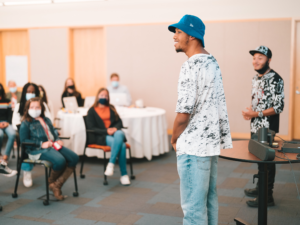5 Ways to Teach Students to Think for Themselves

I believe that real 21st-century learning means preparing students for a world that we can’t even imagine yet.
We won’t be with them when they face that world, so the most important 21st-century skill we can teach our students is how to think for themselves.
I never do any kind of lecture, PowerPoint, presentation or lesson that involves talking at my students. No “sage on the stage,” no dazzling stories, no prezis. Okay, partly that is because I never learned how to set up a PowerPoint let alone make my own. But mostly that is because I really don’t believe in conveying content to my students.
Instead, what I want is to empower my students to find their own answers and communicate those to others. If I can get them curious about a topic, they will teach themselves more than I ever could.
Okay, sounds great, but how does it work in real life? What can you do in the day-to-day classroom to prepare your students for a world that we can’t even imagine yet?
Here are five ways you can help today’s students start thinking for themselves:
1. Let students know that you don’t have all the answers. Last year, I was reading Twelfth Night with a class. It was probably my twentieth time reading the play in my life, but when a student’s interpretation of one of the main characters differed from mine, I admitted to the class that I had missed that meaning.
I love to read challenging poems with my classes and I tell them that, while there are some wrong answers, there are also many right answers and I don’t have them all. Likewise, I don’t know what their thesis statement should be on their next essay or which anecdote they should use in their personal essay. They will have many tougher decisions than that in the future, and the sooner they get used to uncertainty the better.
2. Question everything and encourage them to do the same. I could argue both sides of just about any issue, and I frequently do that in class. I also teach my students that what they are told isn’t necessarily the truth. I want them to feel empowered to find their own answers, but I want them to be able to distinguish between good information and bad. Doing a Google search and reading the first article as 100 percent fact is not a great way to become an informed citizen. Reading multiple sources and learning how to distinguish good ones from iffy ones is.
3. Force students to make their own choices. This may seem like a paradox, but it would be a lot easier on everyone if I called all the shots. I can’t count the number of times that students have begged me to just give them a writing prompt rather than make them come up with their own idea. From reading workshop, to writing workshop, to I-Search papers, I want students to know that their education is their responsibility. I’ll be there to offer tools or structure or advice, but I can’t make them learn.
4. Avoid exams like the plague. I used to give tests on every novel or unit, and what I wanted was for students to repeat back to me what we had discussed in class. I suppose that I was nervous that they weren’t listening or paying attention. But I have moved more and more away from standard tests towards alternative assessments. I want them to show me what they can do with what they have learned, not just repeat it back to me.
5. Push them to try new things. Creative writing might not be an obvious 21st-century skill, but getting students to constantly grow their comfort zone by pushing them to try something new is important. If they can make up a poem or write a group play, then they will be more likely to be able to try whatever new thing is demanded of them from the 2026 workplace. The kids who are rigid and afraid as teenagers will never succeed as adults.
Creative writing assignments based on emojis or math problems based on Pokemon Go might seem timely, but they are not doing students any favors. Focusing on what is popular now isn’t the same as preparing students with the skills that they will need to face a constantly changing and evolving world.
For more, see:
- 6 Strategies for Teaching Public Policy
- How Dialogue Teaches Critical Thinking & Empathy
- Reading Curriculum: Critical Thinking & Creativity for Understanding







0 Comments
Leave a Comment
Your email address will not be published. All fields are required.